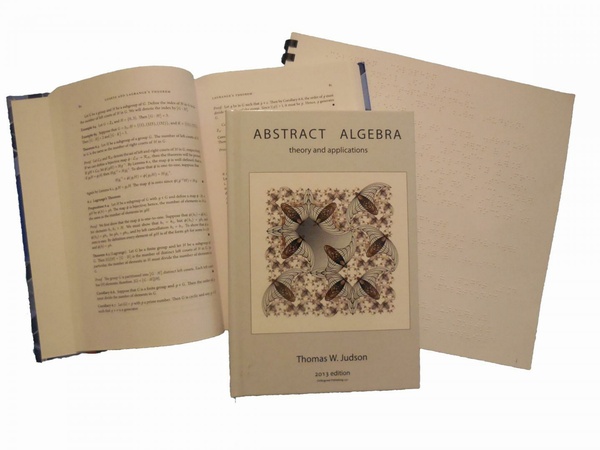A new proof-of-concept approach may be a breakthrough. A new authoring system which serves as a "universal translator" for textbook formats combined with enhancements to the standard method for putting mathematics in a Web page means Braille textbooks could become easy to produce, and therefore fas less expensive, and therefore more widespread.
Towson University Emeritus Professor Martha Siegel met a blind student who needed a statistics textbook for a required course but such a book was special order and required six months and several thousand dollars to translate. Siegel got together with Al Maneki, a retired (and blind) NSA mathematician who serves as senior STEM advisor to the National Federation of the Blind to do something about that.

Undergraduate math textbook translated into Braille using the new, automated method. Image provided by American Institute of Mathematics.
Automating the process is the key, because currently Braille books are created by skilled people retyping from the printed version, which involves considerable time and expertise and therefore cost. Converting the words is easy: Braille is just another alphabet. The hard part is conveying the structure of the book in a non-visual way, converting the mathematics formulas, and converting the graphs and diagrams.
There are three main problems to solve when producing a Braille version of a textbook. First is the overall structure. A typical textbook uses visual clues to indicate chapters, sections, captions, and other landmarks. In Braille all the letters are the same size and shape, so these structural elements are described with special symbols. The other key issues are accurately conveying complicated mathematics formulas, and providing a non-visual way to represent graphs and diagrams.
The first problem was solved by a system developed by team member Rob Beezer, a math professor at the University of Puget Sound in Washington. Beezer sees this work as a natural extension of a dream he has been pursuing for several years. "We have been developing a system for writing textbooks which automatically produces print versions as well as online, EPUB, Jupyter, and other formats. Our mantra is Write once, read anywhere."
Beezer added Braille as an output format in his system, which is called PreTeXt. Approximately 100 books have been written in PreTeXt, all of which can now be converted to Braille.
Math formulas are represented using the Nemeth Braille Code, initially developed by the blind mathematician Abraham Nemeth in the 1950s. The Nemeth Braille in this project is produced by MathJax, a standard package for displaying math formulas on web pages. Team member Volker Sorge, of the School of Computer Science at the University of Birmingham, noted, "We have made great progress in having MathJax produce accessible math content on the Web, so the conversion to Braille was a natural extension of that work." Sorge is a member of the MathJax consortium and the sole developer of Speech Rule Engine, the system that is at the core of the Nemeth translation and provides accessibility features in MathJax and other online tools.
"Some people have the mistaken notion that online versions and screen readers eliminate the need for Braille," commented project co-leader Al Maneki. Sighted learners need to spend time staring at formulas, looking back and forth and comparing different parts. In the same way, a Braille formula enables a person to touch and compare various pieces. Having the computer pronounce a formula for you is not adequate for a blind reader, any more than it would be adequate for a sighted reader.
It will be particularly useful for visually impaired students to have simultaneous access to both the printed Braille and an online version.
Graphs and diagrams remain a unique challenge for representing non-visually. Many of the usual tools of presenting information using color or thickness of a line, shading, etc., are not available in tactile graphics. The tips of our fingers have a much lower resolution than our eyes, so the size of the image has to be bigger (yet still fit on the page). The labels that are included in the picture have to be translated to Braille, and placed so that they do not interfere with the drawn lines. Diagrams that show three-dimensional shapes are particularly hard to "read" in a tactile format. Ongoing work will automate the process of converting images to tactile graphics.
The collaboration which solved the problem was formed in January, 2019, with the help of the American Institute of Mathematics.
"Mathematics teachers who have worked with visually impaired students understand the unique challenges they face," said Henry Warchall, Senior Adviser in the Division of Mathematical Sciences at the National Science Foundation. "By developing an automated way to create Braille mathematics textbooks, this project is making mathematics significantly more accessible, advancing NSF's goal of broadening participation in the nation's scientific enterprise."





Comments